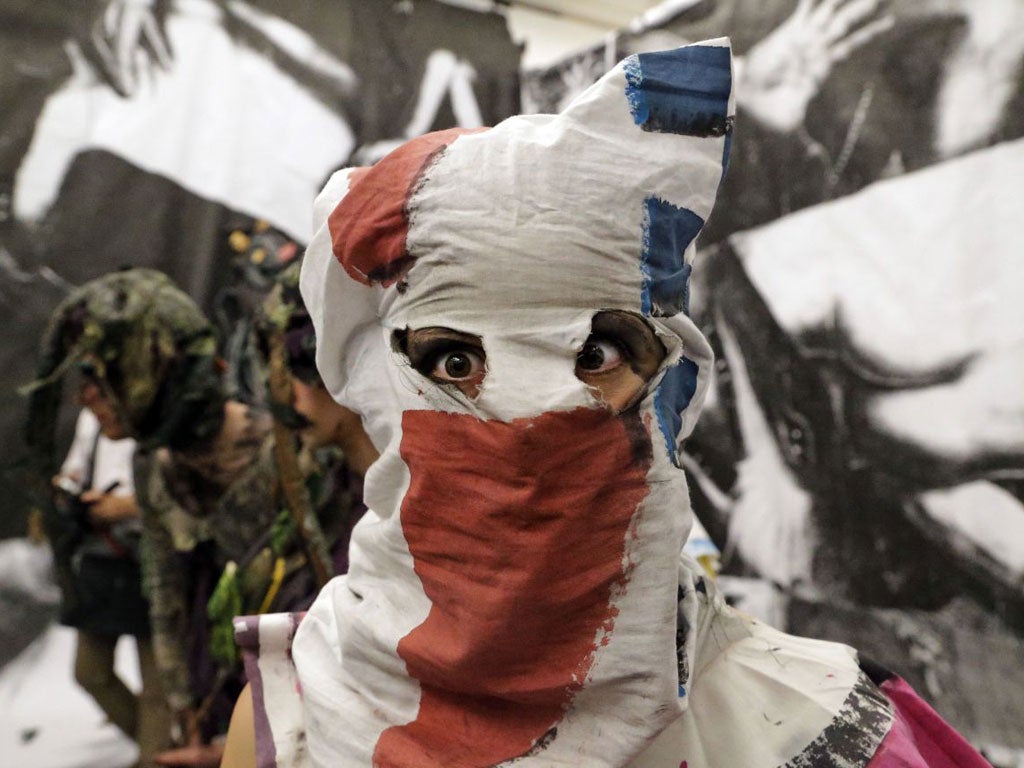The Turner Prize 2012, Tate Britain, London
Another year, another gladiatorial contest, racked with anguish and ambition – but at least 2012's entries have some merit

It can only be a matter of time before the Tate, in the manner of X Factor, televises the judging of the Turner Prize. Picture the scene: the nice judge, the nasty judge, the one who wants to sleep with contestants; and between them Nicholas Serota, thin-lipped as he hisses: "Paul [or Elizabeth, or whoever], you are in/out of the show."
All of which is to say that, were it not for its gladiatorial element, would anyone care about the Turner? The view put about by the Tate is that it is an annual pulse-taking of British art, an uncovering of the newest and best. Never mind that the prize pits artists with careers of 10 years against others with 30, or lens-based makers against muralists. People like the tears of joy or sorrow as some arbiter of contemporary taste – Madonna, say, or Dennis Hopper – opens the fateful envelope and ponies up the forty grand. It could be singers doing the weeping, or fat people or GPs. The point is the anguish.
Ah, well. At least the work in this year's Turner is mostly sensible and well-made, no doubt too much so for some tastes. Paul Noble is an intelligent choice, and, given the glacial pace of his work, could probably not have competed before. Noble is best known for Nobson Newtown, an imagined place he has been drawing in pencil since 1996. As the drawings in question are very big and very meticulous –Villa Joe (Front) is perhaps 15ft by 15ft – they are extraordinarily slow to make. One work, Small Trev, is dated 1996-2006.
Starting with a word in a font of his own devising, Noble works outwards to create an entire cityscape, often with landscape beyond. The flattened perspective of these derives from military maps, and has something of the hyper-rational irrationality of M C Escher. Given Noble's clear interest in turds, you might think of his art as topoography. The villa aforementioned is built up of beautifully drawn stools, while the Henry Moore-ish sculptures in Villa Joe (Rear) suggest the derivation of the phrase "turd in the plaza". Seeing so much of Noble's work together gives a sense of the scale of his project, and his dystopic world looks good in Tate Britain's bland basement rooms.
Luke Fowler was 17 when Noble started on Nobson, and is only 33 now. This is alarming: his Turner show work is eerily clever and mature. A still and moving film questions the way we construct reality, debunking the idea of visual truth, the possibility of neutral documentary.
Take, at random, Alasdair, Hogmanay, Clouston Street. A photographic diptych, one side of Fowler's joined-up image shows a man, the other a place. From the title and juxtaposition, we make up a narrative – Alasdair was in Clouston Street for Hogmanay. Actually, the work makes no such claim. The story is all our own.
This invention of narratives becomes more worrisome when it involves a man whose job was analysing them. R D Laing was a prime mover in the anti-psychiatry movement of the 1960s, and is now largely vilified. By splicing archival film of Laing at work with footage from his own life, Fowler's feature-length, hour-and-a-half video, All Divided Selves, makes us by turns analyst, analysand and voyeur. In exposing documentary as a game of mirrors, this maybe-documentary rescues Laing from history. It is an extraordinary piece of work.
It makes one sorry for Elizabeth Price, whose 20-minute The Woolworths Choir of 1979 it overshadows. Price, too, uses archive film as a readymade. Here, three very different sources – an OU film on church architecture, 1970s news footage of a fire and clips of girl bands – are woven to create a fourth, oddly coherent, story. Price's roots lie in the juxtapositions of Surrealism. What emerges from The Woolworths Choir of 1979 is a syncretic history, in which the Greek khoros becomes both a church choir and the Pussycat Dolls and meets its end in a burning shop in Manchester. It is like a movie short of Frazer's Golden Bough, a stylish, clever work, but it suffers from being in the same show as Fowler's bigger and better film.
Which just leaves Spartacus Chetwynd, of whom I can say little. Critics have blind spots, and mine is performance; particularly the kind that involves audience participation, particularly when I am in the audience. In The Oracle, actors dressed like Stingray characters drag viewers from their seats and whisper predictions in their ears. A colleague on another paper, an amiable man well on in years, was told he would start a new outbreak of avian flu. Not very cheering. Chetwynd's submission also includes an inflatable vinyl bench, which is comfortable if a little wobbly.
Critic's choice
The Liverpool Biennial is in full flow; with work by 60 international artists on show around the city, there’s plenty to see, such as The Lift by Oded Hirsch. The theme this year is hospitality – so do drop in before 25 November.
In London, the Frieze Art Fair descends on Regent’s Park: browse the best of contemporary art, head to the Frieze Masters tent for the long view, or just enjoy the sculpture park, selected by Clare Lilley (11 to 14 Oct).
Join our commenting forum
Join thought-provoking conversations, follow other Independent readers and see their replies
Comments
Bookmark popover
Removed from bookmarks